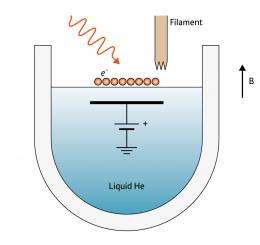Microwave photons can nullify the conductivity of electrons confined to the surface of liquid helium

Trapping electrons in a flat plane prevents them from moving freely in the third dimension and opens the door to a whole range of unusual physics. These effects are harnessed, for example, in modern ultrafast transistors, which confine electrons to thin layers of high-quality semiconductor crystals such as gallium arsenide. But scattering from impurities in semiconductors can mask the deeper underlying physics of these so-called two-dimensional electron gases (2DEGs). Liquid helium may provide an alternative to semiconductors since it is largely impurity free. Using this approach, Denis Konstantinov and Kimitoshi Kono from the RIKEN Advanced Science Institute (Japan) have demonstrated a novel effect where light totally switches off the conductivity of 2DEGs.
Two-dimensional electron gases form naturally at the surface of helium because an intrinsic energy barrier prevents electrons from penetrating any deeper into the liquid. These gases vary markedly from their three-dimensional counterparts because the electron motion in one direction becomes quantized—that is, their velocity in this direction is governed by quantum mechanics and is restricted to a range of discrete values.
Konstantinov and Kono cooled liquid helium-3 to 0.3 kelvin. They supplied electrons from a nearby hot filament, and applied voltage to a plate below the helium to control the number of electrons per unit area. Then, they fired microwave radiation at the 2DEG (Fig. 1) and measured the longitudinal conductivity— the current induced by an electric field applied along one direction—as a function of external magnetic field. They saw that the conductivity periodically fell to zero as they increased the magnetic field. When they switched off the source of microwave photons, however, this effect ceased.
This previously unidentified nullifying effect of microwave photons on conductivity is a consequence of energy-conserved scattering of the liquid helium’s electrons between different energy states—specifically, the first excited and ground sub-bands. “When the electrons stay in the ground sub-band, the effects are rather dull,” says Kono. “In our experiment, absorption of microwave photons transfers electrons to a higher energy sub-band,” Konstantinov adds. “As we change the magnetic field, the energies of states in two subbands cross, and scattering redistributes electrons between the sub-bands.”
Kono and Konstantinov believe that the result will lead to the observation of more novel phenomena in these two-dimensional systems when they are shifted out of their equilibrium state. “The study of nonequilibrium transport in the extremely clean helium system will complement studies of electron transport in semiconductors,” explains Konstantinov.
More information: Konstantinov, D. & Kono, K. Photon-induced vanishing of magnetoconductance in 2D electrons on liquid helium. Physical Review Letters 105, 226801 (2010). prl.aps.org/abstract/PRL/v105/i22/e226801
Provided by RIKEN




















